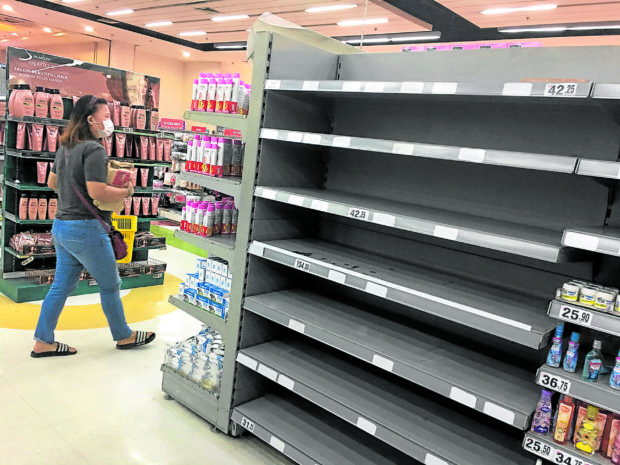
OUT OF STOCK A shopper walks past empty shelves at a grocery store in Makati City. —NIÑO JESUS ORBETA
MANILA, Philippines — While inflation is trending down in the Philippines, there’s one household item that has seen price spikes due to robust demand: toilet paper.
The price of toilet paper in the Philippines has increased by 17.76 percent in just four weeks, making it the sixth country in the world with the highest toilet paper inflation, according to a new research by finder.com, an Australia-based fintech company.
The study, which tracked user-contributed data from cost of living calculator expatistan.com from March 25 to April 22, showed that toilet paper prices in the Philippines rose from an average of $1.07 per four rolls to $1.26.
The nearly 18 percent price spike was well above the global average price increase of 3.37 percent for the same period.
This was even as the average price of goods typically consumed by Filipino households rose at a slower pace of 2.2 percent year-on-year in April compared with the 2.5- percent inflation in March.
Supply and demand
In a statement on Monday, Finder’s global editor in chief Angus Kidman said the surge in toilet paper prices could be blamed on supply and demand problems arising from the coronavirus pandemic.
“With panic-buying setting in around the world, a number of common household items have been in short supply. While the Department of Trade and Industry (DTI) was quick to announce a price freeze on basic necessities, there are always going to be those that look to capitalize on shortages by driving up the prices,” he said.
The jump in the price of toilet paper in the Philippines was well above what was seen in most other countries.
Of the 90 countries included in this research, the Philippines was one of nine that saw a double-digit percentage increase in toilet paper prices.
“COVID-19 is changing all facets of daily life, from going to work, to seeing friends and family, to shopping at the supermarket. Among the biggest changes is the ability to find and buy toilet paper, with panic buyers purchasing so much that there have been shortages worldwide. Even Google has seen a spike in the number of people searching for toilet paper,” the fintech firm said.
Other countries
The spike in Philippine toilet paper prices, however, was not as much as that seen in Norway, where prices jumped by 67.53 percent from $2.71 to $4.54 per four rolls; or in Singapore, which prices surged by 48.84 percent, during the same period, the study showed.
Other countries that had seen a similar upswing during the same period were Cyprus (35.08 percent), Austria (33.85 percent) and Malaysia (32.26 percent).
By region, toilet paper prices rose at the fastest pace in Asia, where prices increased by an average of 7.56 percent, followed by Oceania (6.15 percent), Europe (4.62 percent) and South America (0.77 percent).
Kidman was quick to point out that the Expatistan numbers were self-reported and limited in use.
“We don’t know definitively whether price increases are due to retailers charging more for in-demand products or whether people are simply reporting higher prices,” he said. INQ

